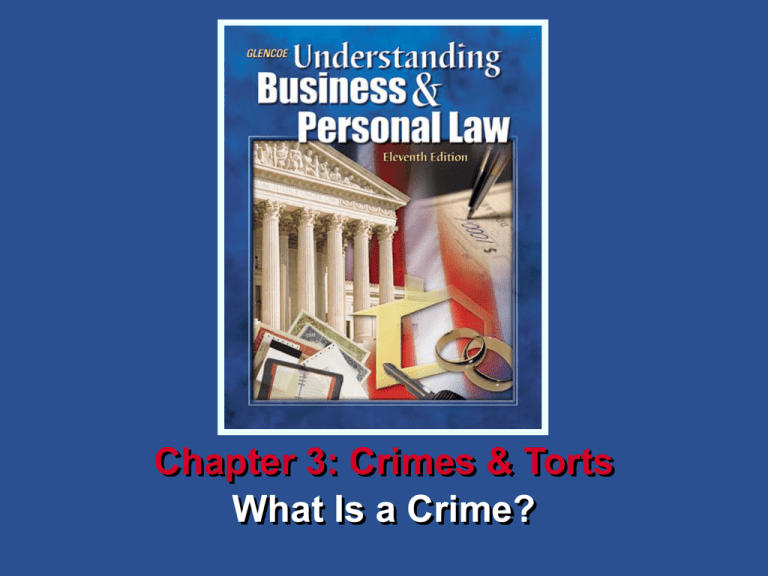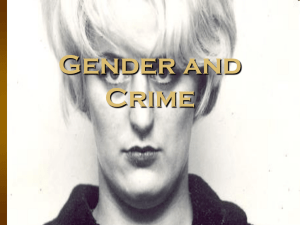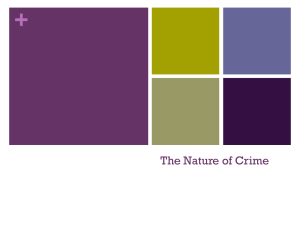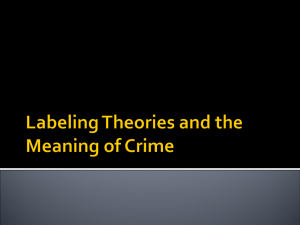
Chapter
3
SECTION OPENER / CLOSER:
INSERT BOOK COVER ART
Chapter 3: Crimes & Torts
What Is a Crime?
Section 3.1 What Is a Crime?
What You’ll Learn
How to tell the difference between
serious and less serious crimes (p. 56)
How to explain the difference between
state and federal law (pp. 56 & 57)
Understanding Business and Personal Law
Criminal Law
Section 3.1 What Is a Crime?
What You’ll Learn
How to explain the elements of a crime
(p. 58)
How to define the various defenses to
criminal liability (p. 59)
Understanding Business and Personal Law
Criminal Law
Section 3.1 What Is a Crime?
Why It’s Important
Learning the essence of criminal law, the
types of crimes that can be committed, and
the nature of criminal defense will help you
understand our criminal justice system.
Understanding Business and Personal Law
Criminal Law
Section 3.1 What Is a Crime?
Section Outline
Classifications of Crimes
Felonies
Misdemeanors
Criminal Law in the American
System
State Criminal Law
Federal Criminal Law
Understanding Business and Personal Law
Criminal Law
Section 3.1 What Is a Crime?
Section Outline
Elements of a Crime
Criminal Act
Required State of Mind
Motive
Understanding Business and Personal Law
Criminal Law
Section 3.1 What Is a Crime?
Section Outline
Defenses to Crimes
Insanity
Entrapment
Self-Defense
Defense of Family Members
Understanding Business and Personal Law
Criminal Law
Section 3.1 What Is a Crime?
Classifications of Crimes
Crime is considered an act against
the public good.
The defendant is the person
accused of a crime.
The prosecutor is the government
attorney who presents the case in
court against the defendant.
Understanding Business and Personal Law
Criminal Law
Section 3.1 What Is a Crime?
Classifications of Crimes
The plaintiff is the party that
accuses a person of a crime.
In criminal proceedings, the state or
federal government, representing
the public at large, is the plaintiff.
Understanding Business and Personal Law
Criminal Law
Section 3.1 What Is a Crime?
Felonies
A felony is a major crime punishable
by imprisonment or death. These
include:
Murder
Manslaughter
Burglary
Robbery
Arson
Understanding Business and Personal Law
Criminal Law
Section 3.1 What Is a Crime?
Misdemeanors
A less serious crime with less sever
penalty is a misdemeanor. These
include:
Driving without a license
Lying about one’s age to purchase
alcohol
Leaving the scene of an automobile
accident
Understanding Business and Personal Law
Criminal Law
Section 3.1 What Is a Crime?
Criminal Law in the
American System
The American legal system consists of
two systems:
The state system, and
The federal system.
Understanding Business and Personal Law
Criminal Law
Section 3.1 What Is a Crime?
State Criminal Law
Each state has inherent police power
allowing it to make statutes to protect
public:
Health
Safety
Welfare
Morals
Understanding Business and Personal Law
Criminal Law
Section 3.1 What Is a Crime?
Federal Criminal Law
The federal government has no
police power.
It can create criminal statutes only
in areas over which it has
jurisdiction, such as counterfeiting,
because it has the power to coin
money.
Understanding Business and Personal Law
Criminal Law
Section 3.1 What Is a Crime?
Federal Criminal Law
Because of the Commerce Clause
of the U.S. Constitution, the federal
government has the power to
regulate commerce among the
states.
As a result, federal criminal law
must involve some sort of interstate
activity.
Understanding Business and Personal Law
Criminal Law
Section 3.1 What Is a Crime?
Federal Criminal Law
Today, the federal government does
have a criminal code and several
police agencies, including:
The Federal Bureau of Investigation
(FBI)
The Drug Enforcement Agency
(DEA)
Understanding Business and Personal Law
Criminal Law
Section 3.1 What Is a Crime?
Elements of a Crime
A crime is defined by two elements:
The criminal act, and
The required state of mind.
Understanding Business and Personal Law
Criminal Law
Section 3.1 What Is a Crime?
Criminal Act
Most criminal statutes specifically
explain conduct that is forbidden.
A criminal act must also involve
voluntary conduct.
Understanding Business and Personal Law
Criminal Law
Section 3.1 What Is a Crime?
Required State of Mind
The definition of a crime can be
changed based on the criminal’s state
of mind.
Murder is the intentional taking of a
person’s life.
Involuntary manslaughter outlaws
the accidental taking of a person’s
life.
Understanding Business and Personal Law
Criminal Law
Section 3.1 What Is a Crime?
Motive
Motive plays no part in proving
criminal liability.
Understanding Business and Personal Law
Criminal Law
Section 3.1 What Is a Crime?
Pre-Learning Question
What do you think are defenses to a
crime?
Understanding Business and Personal Law
Criminal Law
Section 3.1 What Is a Crime?
Defenses to Crimes
Defense attorneys try to show that the
prosecution failed to prove the
required elements for the crime
charged to their client.
Understanding Business and Personal Law
Criminal Law
Section 3.1 What Is a Crime?
Defenses to Crimes
Common defenses are:
Insanity
Entrapment
Self-defense
Defense of family members
Understanding Business and Personal Law
Criminal Law
Section 3.1 What Is a Crime?
Insanity
American law recognizes that people
cannot be held responsible for their
actions if they do not know what they
are doing.
Understanding Business and Personal Law
Criminal Law
Section 3.1 What Is a Crime?
Insanity
About two-fifths of the U.S. use the
M’Naghten Rule and the other threefifths use the American Law Institute
(ALI) test to determine insanity.
Understanding Business and Personal Law
Criminal Law
Section 3.1 What Is a Crime?
Entrapment
If a law enforcement officer induces a
law-abiding citizen to commit a crime,
the person can use a defense known
as entrapment.
Understanding Business and Personal Law
Criminal Law
Section 3.1 What Is a Crime?
Self-Defense
When people have good reason to
believe they are in danger of serious
injury or death, they can use force to
protect themselves.
This is defense is known as selfdefense.
Understanding Business and Personal Law
Criminal Law
Section 3.1 What Is a Crime?
Defense of Family Members
Using force to rescue a family
member from attack is another
defense.
As with self-defense, the rescuer must
have good reason to believe the victim
was in danger of severe bodily harm
or death.
Understanding Business and Personal Law
Criminal Law
Section 3.1 What Is a Crime?
Section 3.1 Assessment
Reviewing What You Learned
1. What determines the difference
between a felony and a
misdemeanor?
Understanding Business and Personal Law
Criminal Law
Section 3.1 What Is a Crime?
Section 3.1 Assessment
Reviewing What You Learned
Answer
Felonies are more serious than
misdemeanors and are distinguished by
longer, more severe penalties.
Understanding Business and Personal Law
Criminal Law
Section 3.1 What Is a Crime?
Section 3.1 Assessment
Reviewing What You Learned
2. How do state and federal criminal
law differ?
Understanding Business and Personal Law
Criminal Law
Section 3.1 What Is a Crime?
Section 3.1 Assessment
Reviewing What You Learned
Answer
State governments have inherent police
power. It can make statutes to protect the
public.
Understanding Business and Personal Law
Criminal Law
Section 3.1 What Is a Crime?
Section 3.1 Assessment
Reviewing What You Learned
Answer
The federal government has no police
power and can create criminal statutes only
in those areas over which it has
jurisdiction.
Understanding Business and Personal Law
Criminal Law
Section 3.1 What Is a Crime?
Section 3.1 Assessment
Reviewing What You Learned
3. What are the elements of a crime?
Understanding Business and Personal Law
Criminal Law
Section 3.1 What Is a Crime?
Section 3.1 Assessment
Reviewing What You Learned
Answer
The criminal act and the required state of
mind.
Understanding Business and Personal Law
Criminal Law
Section 3.1 What Is a Crime?
Section 3.1 Assessment
Reviewing What You Learned
4. What are the major criminal
defenses?
Understanding Business and Personal Law
Criminal Law
Section 3.1 What Is a Crime?
Section 3.1 Assessment
Reviewing What You Learned
Answer
Insanity, entrapment, self-defense, and
defense of family members.
Understanding Business and Personal Law
Criminal Law
Section 3.1 What Is a Crime?
Section 3.1 Assessment
Critical Thinking Activity
Legal Defenses
Why is it crucial to understand the different
defenses to criminal liability?
Understanding Business and Personal Law
Criminal Law
Section 3.1 What Is a Crime?
Section 3.1 Assessment
Critical Thinking Activity Answer
Legal Defenses
In order to properly represent his or her
client, an attorney must have a proper
understanding of the different defenses to
criminal liability.
Understanding Business and Personal Law
Criminal Law
Chapter
3
SECTION OPENER / CLOSER:
INSERT BOOK COVER ART
End of Section 3.1
What Is a Crime?
Chapter
3
SECTION OPENER / CLOSER:
INSERT BOOK COVER ART
Section 3.2
What Is a Crime?
Section 3.1 What Is a Crime?
What You’ll Learn
How to define major crimes against
people (p. 62)
How to define major crimes against
property (p. 66)
Understanding Business and Personal Law
Criminal Law
Section 3.1 What Is a Crime?
What You’ll Learn
How to define major crimes that involve
controlled substances (p. 71)
How to define major crimes that involve
computers (p. 71)
Understanding Business and Personal Law
Criminal Law
Section 3.1 What Is a Crime?
Why It’s Important
Learning how to distinguish among various
crimes will help you understand criminal
liability.
Understanding Business and Personal Law
Criminal Law
Section 3.1 What Is a Crime?
Section Outline
Crimes Against People
Murder
Manslaughter
Assault and Battery
Kidnapping
Sex Offenses
Domestic Violence
Hate Crimes
Understanding Business and Personal Law
Criminal Law
Section 3.1 What Is a Crime?
Section Outline
Crimes Against Property
Burglary
Larceny
Embezzlement
Robbery
Arson
Vandalism
Shoplifting
Understanding Business and Personal Law
Criminal Law
Section 3.1 What Is a Crime?
Section Outline
Motor Vehicle Violations
Crimes Involving Controlled
Substances
Alcohol
Drugs
Understanding Business and Personal Law
Criminal Law
Section 3.1 What Is a Crime?
Section Outline
Computer Crimes
Federal Crimes and Laws
State Crimes and Computers
Understanding Business and Personal Law
Criminal Law
Section 3.1 What Is a Crime?
Pre-Learning Question
What do you think are crimes against
people?
Understanding Business and Personal Law
Criminal Law
Section 3.1 What Is a Crime?
Crimes Against People
Some crimes can be specifically
categorized as crimes against people.
Understanding Business and Personal Law
Criminal Law
Section 3.1 What Is a Crime?
Murder
Murder is the unlawful killing of
another human being with malice
aforethought.
Understanding Business and Personal Law
Criminal Law
Section 3.1 What Is a Crime?
Manslaughter
Manslaughter is the unlawful killing of
another human being without malice
aforethought.
Understanding Business and Personal Law
Criminal Law
Section 3.1 What Is a Crime?
Assault and Battery
Battery is the unlawful touching of
another person.
Assault is an attempt to commit
battery.
Understanding Business and Personal Law
Criminal Law
Section 3.1 What Is a Crime?
Kidnapping
Kidnapping is the unlawful removal
or restraint of a person against his or
her will.
Understanding Business and Personal Law
Criminal Law
Section 3.1 What Is a Crime?
Sex Offenses
Sex offenses include statutory rape
and sexual assault.
Understanding Business and Personal Law
Criminal Law
Section 3.1 What Is a Crime?
Domestic Violence
Domestic violence is any reckless
form of physical or mental abuse
within a family or household.
Understanding Business and Personal Law
Criminal Law
Section 3.1 What Is a Crime?
Hate Crimes
Actions using certain symbols,
writings, pictures, or spoken words to
cause fear or anger in people because
of their race, religion, color, or gender
are known as hate crimes.
Understanding Business and Personal Law
Criminal Law
Section 3.1 What Is a Crime?
What is the difference between
murder and manslaughter?
Understanding Business and Personal Law
Criminal Law
Section 3.1 What Is a Crime?
ANSWER
Murder indicates malice aforethought
and manslaughter does not.
Understanding Business and Personal Law
Criminal Law
Section 3.1 What Is a Crime?
Pre-Learning Question
What do you think are crimes against
property?
Understanding Business and Personal Law
Criminal Law
Section 3.1 What Is a Crime?
Crimes Against Property
Common crimes against property
include burglary, larceny,
embezzlement, robbery, arson,
vandalism and shoplifting.
Understanding Business and Personal Law
Criminal Law
Section 3.1 What Is a Crime?
Burglary
Burglary is the breaking and entering
of homes and other places with the
intent to commit a misdemeanor or a
felony.
Understanding Business and Personal Law
Criminal Law
Section 3.1 What Is a Crime?
Larceny
Larceny is the unlawful taking and
carrying away of the personal property
of another with the intent to deprive
the owner of the property.
Understanding Business and Personal Law
Criminal Law
Section 3.1 What Is a Crime?
Embezzlement
Embezzlement is the wrongful taking
of another’s property by a person who
has been entrusted with that property.
Understanding Business and Personal Law
Criminal Law
Section 3.1 What Is a Crime?
Robbery
Robbery is the wrongful taking and
carrying away of the personal property
of another through violence or threats.
Understanding Business and Personal Law
Criminal Law
Section 3.1 What Is a Crime?
Arson
Arson is the willful and malicious
burning of homes and other buildings.
Understanding Business and Personal Law
Criminal Law
Section 3.1 What Is a Crime?
Vandalism
Vandalism is the willful or malicious
damage to property.
Understanding Business and Personal Law
Criminal Law
Section 3.1 What Is a Crime?
Shoplifting
Shoplifting is the act of stealing
goods from a store.
Understanding Business and Personal Law
Criminal Law
Section 3.1 What Is a Crime?
During the time Joe Banks worked at
the Stop and Go gas station, he put
nearly 600 gallons of gasoline into his
own car without paying for it. What
crime is he probably guilty of?
Understanding Business and Personal Law
Criminal Law
Section 3.1 What Is a Crime?
ANSWER
Embezzlement
Understanding Business and Personal Law
Criminal Law
Section 3.1 What Is a Crime?
Pre-Learning Question
What do you think are motor vehicle
violations?
Understanding Business and Personal Law
Criminal Law
Section 3.1 What Is a Crime?
Motor Vehicle Violations
Drag racing—the unauthorized
racing of two vehicles side by side
and the timing of vehicles that
separately run a prearranged
course.
Joyriding—taking temporarily a
motor vehicle without the owner’s
permission.
Understanding Business and Personal Law
Criminal Law
Section 3.1 What Is a Crime?
Pre-Learning Question
Why are alcohol, tobacco, and drugs
considered controlled substances?
Understanding Business and Personal Law
Criminal Law
3.2
Section
3.1 What Is a Crime?
Crimes Involving Controlled
Substances
Federal
and
state
governments
control who
may or may
not possess
or use
Understanding Business and Personal Law
alcohol
tobacco
drugs
Criminal Law
Section 3.1 What Is a Crime?
Computer Crimes
Computers and network devices
have introduced new ways to
commit crimes.
Both federal and state statutes
address this new legal problem.
Understanding Business and Personal Law
Criminal Law
Section 3.1 What Is a Crime?
Federal Computer Laws
The Computer Fraud and Abuse Act
is aimed at computer hackers.
The National Information
Infrastructure Act outlaws the
extortion of money or other favors in
exchange for not causing a
computer system to crash.
Understanding Business and Personal Law
Criminal Law
Section 3.1 What Is a Crime?
State Computer Laws
Computer trespass outlaws using a
computer for any crime.
Computer fraud statutes make it an
offense to use a computer to
acquire property, services, or money
by fraud.
Understanding Business and Personal Law
Criminal Law
Section 3.1 What Is a Crime?
State Computer Laws
Some states have a detailed list of
computer-related crimes including:
Theft of computer services
Destruction of equipment
Misuse of computer information
Understanding Business and Personal Law
Criminal Law
Section 3.1 What Is a Crime?
Section 3.2 Assessment
Reviewing What You Learned
1. What are the major crimes
committed against people?
Understanding Business and Personal Law
Criminal Law
Section 3.1 What Is a Crime?
Section 3.2 Assessment
Reviewing What You Learned
Answer
Murder, manslaughter, assault, battery,
kidnapping, sex offenses, domestic
violence, and hate crimes.
Understanding Business and Personal Law
Criminal Law
Section 3.1 What Is a Crime?
Section 3.2 Assessment
Reviewing What You Learned
2. What are the major crimes
committed against property?
Understanding Business and Personal Law
Criminal Law
Section 3.1 What Is a Crime?
Section 3.2 Assessment
Reviewing What You Learned
Answer
Burglary, larceny, embezzlement, robbery,
arson, vandalism, and shoplifting.
Understanding Business and Personal Law
Criminal Law
Section 3.1 What Is a Crime?
Section 3.2 Assessment
Reviewing What You Learned
3. What are the major crimes that
involve controlled substances?
Understanding Business and Personal Law
Criminal Law
Section 3.1 What Is a Crime?
Section 3.2 Assessment
Reviewing What You Learned
Answer
Those associated with drugs and alcohol.
Understanding Business and Personal Law
Criminal Law
Chapter
3
SECTION OPENER / CLOSER:
INSERT BOOK COVER ART
End of Section 3.2
What Is a Crime?
Chapter
3
SECTION OPENER / CLOSER:
INSERT BOOK COVER ART
Section 4.1
What Is a Crime?
Section
3.1
Is a Law
Crime?
of Torts
Chapter 4WhatThe
Section 4.1
Intentional Torts
Section 4.2
Negligence and Strict Liability
Understanding Business and Personal Law
Criminal Law
Section 3.1 What Is a Crime?
What You’ll Learn
How to tell the difference between a
crime and a tort (p. 80)
How to explain the nature of tort law (p.
80)
Understanding Business and Personal Law
Criminal Law
Section 3.1 What Is a Crime?
Why It’s Important
Learning the difference between a tort and
a crime, as well as the types of intentional
torts, will help you understand how the
justice system protects people from injury.
Understanding Business and Personal Law
Criminal Law
Section 3.1 What Is a Crime?
Section Outline
The Difference Between Criminal
Law and Tort Law
Intentional Torts
Assault and Battery
Trespass
Nuisance
Understanding Business and Personal Law
Criminal Law
Section 3.1 What Is a Crime?
Section Outline
Intentional Torts, continued
False Imprisonment
Defamation
Invasion of Privacy
Understanding Business and Personal Law
Criminal Law
Section 3.1 What Is a Crime?
Pre-Learning Question
What is the difference between
criminal law and tort law?
Understanding Business and Personal Law
Criminal Law
Section 3.1 What Is a Crime?
The Difference Between
Criminal Law and Tort Law
A crime is an act against not only a
specific individual, but the general
welfare, as well.
A tort is a private wrong committed
by one person against another.
Understanding Business and Personal Law
Criminal Law
Section 3.1 What Is a Crime?
The Difference Between
Criminal Law and Tort Law
A tort will lead the wronged party to try
and recover money as compensation
for the loss or injury suffered.
Understanding Business and Personal Law
Criminal Law
Section 3.1 What Is a Crime?
The Difference Between
Criminal Law and Tort Law
A tort does not, however, call upon the
government to punish the wrongdoer.
Understanding Business and Personal Law
Criminal Law
Section 3.1 What Is a Crime?
The Concept of Rights
The law of torts is grounded in the
concept of rights.
Under tort law all people are entitled
to certain rights.
Understanding Business and Personal Law
Criminal Law
Section 3.1 What Is a Crime?
The Concept of Rights
These include the right to:
Be free from bodily harm.
Enjoy a good reputation
Conduct business without
unwarranted interference.
Understanding Business and Personal Law
Criminal Law
Section 3.1 What Is a Crime?
The Concept of Rights
The law imposes a duty on all of us
to respect the rights of others.
Tort law governs this interplay
between rights and duties.
Understanding Business and Personal Law
Criminal Law
Section 3.1 What Is a Crime?
Pre-Learning Question
What is an intentional tort?
Understanding Business and Personal Law
Criminal Law
Section 3.1 What Is a Crime?
Intentional Torts
Torts can be committed either
intentionally or unintentionally.
An intentional tort occurs when a
person knows and desires the
consequences of his or her act.
Understanding Business and Personal Law
Criminal Law
Section 3.1 What Is a Crime?
Assault and Battery
The tort of assault occurs when one
person deliberately leads another
person to believe that he or she is
about to be harmed.
The tort of battery involves the
unlawful, unprivileged touching of
another person.
Understanding Business and Personal Law
Criminal Law
Section 3.1 What Is a Crime?
Assault and Battery
The tort of assault is different from the
crime of assault.
The victim of a tort assault must
know that the tortfeasor meant to
commit harm.
A tortfeasor is the person who
committed the tort.
Understanding Business and Personal Law
Criminal Law
Section 3.1 What Is a Crime?
Trespass
A trespass is the wrongful damage to
or interference with the property of
another.
Understanding Business and Personal Law
Criminal Law
Section 3.1 What Is a Crime?
Nuisance
The tort of nuisance is anything that
interferes with the enjoyment of life or
property.
Understanding Business and Personal Law
Criminal Law
Section 3.1 What Is a Crime?
False Imprisonment
Law enforcement officers must have
probable cause or a warrant to arrest
someone, or they can be sued for
false imprisonment, or false arrest.
Understanding Business and Personal Law
Criminal Law
Section 3.1 What Is a Crime?
Defamation
Defamation is the wrongful act of
injuring another’s reputation by
making false statements.
Libel is a false statement in written
form.
Slander is a false statement made
orally to a third party.
Understanding Business and Personal Law
Criminal Law
Section 3.1 What Is a Crime?
Invasion of Privacy
Invasion of privacy is interfering with
a person’s right to be left alone, which
includes the right to be free from
unwanted publicity and interference
with private matters.
Understanding Business and Personal Law
Criminal Law
Section 3.1 What Is a Crime?
Section 4.1 Assessment
Reviewing What You Learned
1. What is the difference between a
crime and a tort?
Understanding Business and Personal Law
Criminal Law
Section 3.1 What Is a Crime?
Section 4.1 Assessment
Reviewing What You Learned
2. What concept is at the heart of tort
law?
Understanding Business and Personal Law
Criminal Law
Section 3.1 What Is a Crime?
Section 4.1 Assessment
Reviewing What You Learned
Answer
The law of torts is grounded in the concept
of rights.
Understanding Business and Personal Law
Criminal Law
Section 3.1 What Is a Crime?
Section 4.1 Assessment
Reviewing What You Learned
4. What are the most common
intentional torts?
Understanding Business and Personal Law
Criminal Law
Section 3.1 What Is a Crime?
Section 4.1 Assessment
Reviewing What You Learned
Answer
Assault, battery, trespass, nuisance, false
imprisonment, defamation, and invasion of
privacy.
Understanding Business and Personal Law
Criminal Law
Section 3.1 What Is a Crime?
Section 4.1 Assessment
Critical Thinking Activity
Tort Law
If criminal law is responsible for dealing
with individuals who commit wrongful acts,
what purpose does tort law serve? Why do
you need to understand the different
intentional torts?
Understanding Business and Personal Law
Criminal Law
Section 3.1 What Is a Crime?
Section 4.1 Assessment
Critical Thinking Activity Answer
Tort Law
Tort law compensates victims, and in order
to properly represent his or her client as a
tortfeasor or a victim, an attorney must
have a proper understanding of the
different intentional torts.
Understanding Business and Personal Law
Criminal Law
Section 3.1 What Is a Crime?
Section 4.1 Assessment
Legal Skills in Action
Computer Privacy
Many people, businesses, and government
agencies today have increased access to
computers. Although this access may be of
great convenience, it is also a source of
danger, especially to privacy.
Understanding Business and Personal Law
Criminal Law
Section 3.1 What Is a Crime?
Section 4.1 Assessment
Legal Skills in Action
Computer Privacy
Write a research paper in which you trace
the development of the computer along
with the increased threat to privacy
represented by its development.
Understanding Business and Personal Law
Criminal Law
Section 3.1 What Is a Crime?
Section 4.1 Assessment
Legal Skills in Action Answer
Computer Privacy
Reports will vary, but should cite sources to
support their findings.
Understanding Business and Personal Law
Criminal Law
Chapter
3
SECTION OPENER / CLOSER:
INSERT BOOK COVER ART
End of Section 4.1
What Is a Crime?










